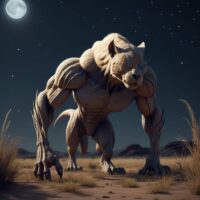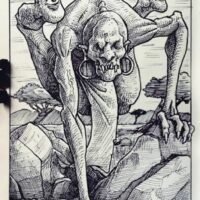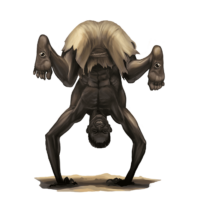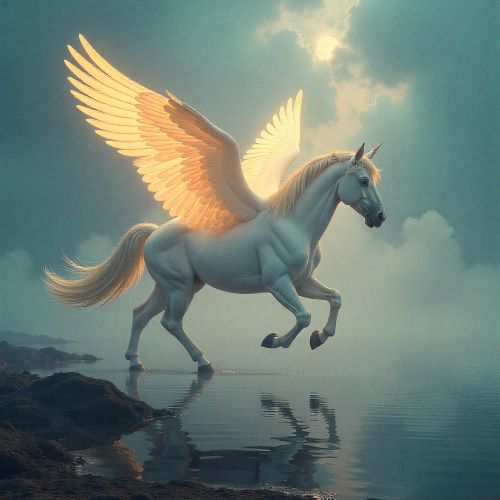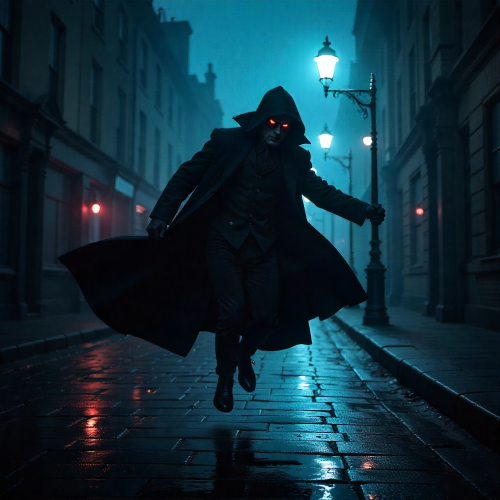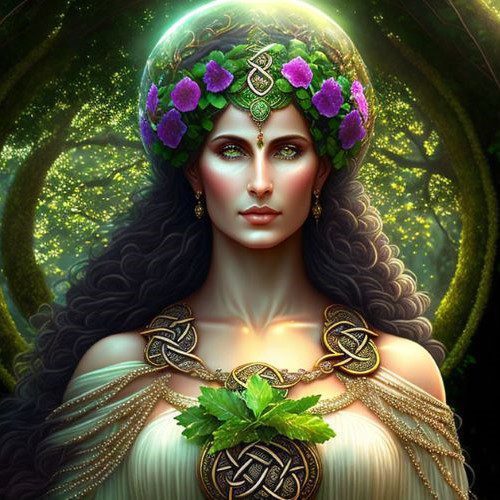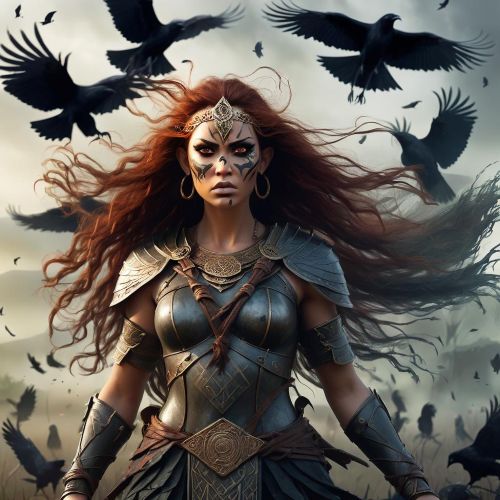Epona : Goddess of Horses
Listen
At a glance
| Description | |
|---|---|
| Origin | Gaulish Mythology |
| Classification | Gods |
| Family Members | N/A |
| Region | France |
| Associated With | Horses, Equestrian animals, Fertility |
Epona
Introduction
Epona stands out in ancient mythology not just as a goddess of horses, but as a symbol of prosperity, protection, and sovereignty across both Celtic and Roman traditions. Rooted in Gaulish culture, her name originates from the word epos, meaning “horse,” paired with the divine suffix -ona, marking her as a sacred figure. Unique among Celtic deities, Epona was embraced across the Roman Empire, where she was officially worshipped—an extraordinary honor that reflected her widespread veneration. Her appeal crossed regional and cultural boundaries, from the tribal horse cultures of Gaul to the imperial cavalry of Rome.
Her importance lay not just in her association with horses but in her role as a guide through life’s transitions, a bestower of fertility, and a divine protector. Celebrated on December 18 in the Roman calendar, her influence was so profound that her cult thrived across Roman Britain, Gaul, Germania, and even North Africa, especially among cavalry units who relied on her for protection and strength.
Physical Traits
Epona is most often visualized through Roman-influenced statuary and reliefs that blend local Celtic aesthetics with classical style. These artworks typically show her seated either side-saddle on a horse or enthroned between two steeds, exuding an aura of peace and gentle authority. Unlike male deities who are often depicted in scenes of battle, Epona’s imagery emphasizes harmony, care, and abundance.
In many depictions, she holds a cornucopia or a basket filled with fruit, indicating her strong ties to fertility and prosperity. Her wardrobe—flowing gowns or tunics, occasionally paired with cloaks—evokes grace rather than grandeur. Some depictions go further, showing her feeding or stroking her horses, a rare intimacy in ancient divine iconography that reflects her nurturing, down-to-earth qualities.
Family
Celtic mythology often preserves its deities without detailed genealogies, and Epona is no exception. There are no surviving myths that speak of her parentage, lovers, or children, suggesting she may have been seen as self-sufficient or sovereign in her own right. Unlike Rhiannon from Welsh mythology or Macha from Irish lore—both of whom have complex relationships and stories—Epona appears more as a solitary guardian, existing outside the familial networks often typical of divine narratives.
However, comparative mythology offers interesting parallels. Scholars sometimes associate her with Rhiannon due to their mutual connection to horses and the underworld. Yet Epona remains distinctly her own—an independent deity focused less on mythological drama and more on constant, practical guardianship.
Other names
While “Epona” remained her primary name across inscriptions and dedications, her worship across the Roman Empire saw her title adapted and expanded. Names like Epona Regina (“Queen Epona”) and Epona Augusta linked her to royal and imperial power, elevating her status among other state-sanctioned deities.
In some personal dedications, she appears as Eponina, a diminutive form suggesting endearment or a more familiar worship relationship. Titles such as “Lady of Horses” or “Mare Goddess” were also used colloquially or descriptively. These varying names did not alter her essential identity but rather reflected the breadth of her appeal—from the military elite to humble farmers.
Powers and Abilities
Epona’s divine powers were deeply rooted in the real-world needs of her worshippers. Her primary domain was the care, safety, and spiritual well-being of horses, mules, and donkeys—animals essential to transportation, farming, and warfare. Soldiers, especially cavalry units, saw her as a source of strength and protection during campaigns. Horse breeders and handlers prayed for her blessings to ensure the health and fertility of their animals.
Beyond physical protection, Epona also held symbolic roles. Some traditions viewed her as a guide to the Otherworld, especially for souls of warriors or travelers lost on the road. This made her a comforting figure in life and in death. Additionally, her association with fertility extended to humans and the earth itself, reinforcing her connection to agricultural abundance and the cycle of seasons.
Some later interpretations even credit her with influencing dreams or offering prophetic visions, positioning her as a mystical bridge between the material and spiritual realms—an embodiment of balance between strength and compassion.
Modern Day Influence
Epona’s legacy didn’t fade with the fall of the Roman Empire. Instead, her memory found ways to endure and evolve. In modern Pagan and Neo-Druid practices, she is revered as a goddess of animals, fertility, and natural cycles. Celebrants invoke her presence during solstice and equinox rituals, especially in ceremonies related to animals, harvest, or travel. Her nurturing, sovereign qualities appeal to contemporary spiritual seekers looking for divine archetypes connected to nature and autonomy.
Folkloric echoes of her worship remain in British and European festivals. For instance, the Cornish Obby Oss festival and horse-blessing rites in southern Europe are seen by some scholars as cultural remnants of Epona’s influence. These celebrations, though no longer explicitly religious, retain symbolic elements—costumed horse figures, parades, and fertility themes—that align with her ancient persona.
In pop culture, Epona’s name reached global audiences through The Legend of Zelda video game franchise, where the hero Link’s loyal steed bears her name. This modern incarnation, while fictional, captures her enduring association with guidance, trust, and companionship. Musical artists like Enya have also honored her, further embedding Epona in the modern imagination.
Her name has also become popular for horse-related businesses, from stables to veterinary practices, and remains a beloved symbol within equestrian circles. For many, invoking Epona is more than historical curiosity—it is a gesture of respect for the sacred bond between humans and horses.
Related Images
Source
Cook, P. D. M. (n.d.). Epona: Hidden Goddess of the Celts. Avalonia Publishing.
Goddess Conference. (2022, July 14). Celtic goddess: Epona, Sovereign Goddess of Avalon. https://goddessconference.com/celtic-goddess-epona-sovereign-goddess-of-avalon/
Mythology Inquirer. (2023, December 7). Epona’s worship in the Celtic world explained. https://mythologyinquirer.com/eponas-worship-in-the-celtic-world-explained/
World History Encyclopedia. (n.d.). Epona. https://www.worldhistory.org/article/153/epona/
Britannica, T. Editors of Encyclopaedia. (2016, December 20). Epona. Encyclopedia Britannica. https://www.britannica.com/topic/Epona
KidZone.ws. (n.d.). Epona, Celtic goddess of horses. https://www.kidzone.ws/mythology/celtic/epona.htm
Patti Wigington. (2017, May 17). Epona, the Gaulish Horse Goddess. https://www.pattiwigington.com/epona-the-gaulish-horse-goddess/
Mythology Vault. (n.d.). Epona Horse Goddess Worship. https://mythologyvault.com/mythologies-by-culture/celtic-mythology/epona-horse-goddess-worship/
Frequently Asked Questions
What is lorem Ipsum?
I am text block. Click edit button to change this text. Lorem ipsum dolor sit amet, consectetur adipiscing elit. Ut elit tellus, luctus nec ullamcorper mattis, pulvinar dapibus leo.
What is lorem Ipsum?
I am text block. Click edit button to change this text. Lorem ipsum dolor sit amet, consectetur adipiscing elit. Ut elit tellus, luctus nec ullamcorper mattis, pulvinar dapibus leo.
What is lorem Ipsum?
I am text block. Click edit button to change this text. Lorem ipsum dolor sit amet, consectetur adipiscing elit. Ut elit tellus, luctus nec ullamcorper mattis, pulvinar dapibus leo.
What is lorem Ipsum?
I am text block. Click edit button to change this text. Lorem ipsum dolor sit amet, consectetur adipiscing elit. Ut elit tellus, luctus nec ullamcorper mattis, pulvinar dapibus leo.
What is lorem Ipsum?
I am text block. Click edit button to change this text. Lorem ipsum dolor sit amet, consectetur adipiscing elit. Ut elit tellus, luctus nec ullamcorper mattis, pulvinar dapibus leo.


